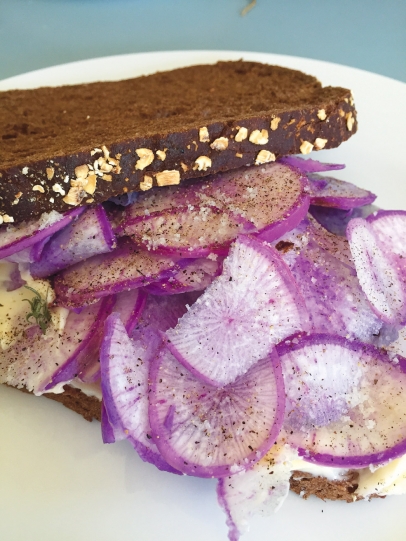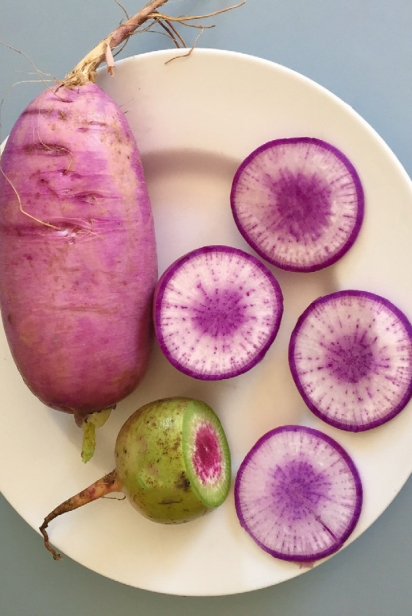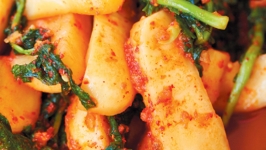Winter Radish, Simple Pleasure
Before the advent of modern transportation, refrigeration and the global movement of food, winter market gardening and root cellars carried us through the long winter months. Once imported foods became available and cheap, many of our heirloom vegetables fell by the wayside. The winter radish was one of them.
Although it is the brightly colored, delicately crisp spring radish that we think of when we think radishes, the spring radish is but a tease of what a radish can be. Winter radishes are a totally different animal than their relative the spring radish; mild, crisp, sweet and unique, harvested in the late fall. It just might be winter’s most convincing argument for eating seasonally.
When little else can be harvested from the cold ground and stored for the long winter ahead, these unusual radishes excel. They can be harvested as late as November and, in cold storage, can last until spring without losing quality. In fact, in storage their flavor only improves, and during winter there is nothing better then the taste of freshness.
Winter radishes are often confused with rutabagas or turnips or sometimes not recognized at all. I saw my first winter radish at a farmers’ market and, even being a farmer myself, I had to ask what it was. It was the first market of the season, in early May, when little was yet to be coaxed out of the ground, but a vendor had piled high on his table, and even more in wooden apple boxes, some of the most unusual vegetables I’d ever seen. Some of these oddities were round and turnip-like, some sausage-shaped, some long and bluntly pointed. The sign above one box of an earthy-looking, dark-green skinned, golf ball-sized vegetable said “Watermelon radish” and it caught my attention. Watermelon radish! I had tried to grow them in the past after seeing seed catalog photos of a striking red-hearted radish with a bright green exterior, but never had any success, which I found odd since spring radishes are such an easy crop.
The vendor sliced one open, exposing its surprisingly bright magenta pink interior, and he told me of its crisp, delicate taste. Then he reached over to the next enormous pile of dusky, purple-skinned, sausage-shaped oddities and explained that they too were winter radishes of perhaps even a more refined character, a Daikon. When fresh, he said, they are bright and smooth on the exterior, but these had been planted in mid-summer, harvested in mid-November, then stored all winter. I couldn’t wait to get some home and try them. No wonder I had failed to grow winter radishes; I assumed they should be planted as an early spring crop. Most winter radishes perform best as a mid-to late-summer planting, but there are some that can be grown as a spring crop and harvested mid-summer as well, such as the Black Spanish.
Once home, my radish-loving granddaughter L’il V stood by as I laid the odd radishes on the cutting board. I sliced the unusually large sausage-shaped radish, exposing a translucent white flesh with a magnificent purple tie-dye ring of color. I was expecting a tough and dry interior but it was the best radish I have ever eaten! L’il Veronica and I gobbled it up. It was crisp, delicate, even a bit creamy, and far more interesting then any radish could be expected to be.
The exact origin of the radish is veiled in mystery. In many cases vegetables can be traced to their origin by their names. If the names for a certain plant throughout different cultures are similar, the way a plant has traveled can be traced, but the immense diversity of radish names prevent any type of definite conclusion on the origin or even the early propagation of the radish by humans. In Europe many names sound similar: ramoraccio in Italian and armoracia in Greek. Semitic languages called it a wide range of names, from fugal to fidgle. In India it was called moola, and entirely different names in China and Japan. Oldest literary references and archaeological remains indicate that the plant could have originated in North China. However, the greatest diversity of radish types is found in the Eastern Mediterranean, indicating that it most likely originated in the area between the Mediterranean and the Caspian Sea, although it is possible that radishes were domesticated separately in both Asia and Europe. In any event, radishes are an ancient crop, even depicted on the walls of the pyramids 4000 years ago.
Eventually many different varieties of radishes spread throughout Europe and Asia, with different countries preferring different varieties. In the West a radish is typically round, small and red, and of the spring planting type, although in Spain the round Black Spanish winter radish is preferred. White on the inside and a rugged black on the outside, it is spicier than many and is at home paired with a slice of sharp cheddar and a mug of beer. The Munich Bier radish in Germany is another variety that strays from the norm in the West. A very interesting winter radish grown for its edible seed pods as well as its large, white, tapered root, it’s said to be the perfect accompaniment to a good dark beer, with its peppery and earthy flavor. Spiral cut and served with a sprinkle of chopped chives, it has become a traditional treat in Germany during Oktoberfest.
The Daikon radish is relished in Asia. Asian radishes range in color from red or pink to green but mainly white, in shapes from round to oblong to tapered, and in pungency from mild to spicy hot. Daikon is perhaps the most familiar radish categorized as a winter radish. Some Daikon can grow to be close to two feet long. They are fabulous when chopped roughly and sautéed or stir-fried, similar to the crunchy surprise of water chestnuts. Some of the most beautiful Daikon are the purple and rose colored varieties such as the sausage-shaped beauty I brought home from the market, listed by Johnny Seed under the name Bravo.
There are even some winter radishes that have both an edible bulb and leaves and are prized in Korean cooking in a dish called kimchi. In this case, the Ponytail radish, a mild, white-fleshed tender treat with abundant, hairless leaves.
Another outstanding radish from North China is the Shawo Fruit radish. This cylindrical, lime green variety is reputed to be crisp and sweet, considered a tasty fruit substitute similar in texture and taste to pear. One grower of this radish claimed its flavor is like honeydew/cucumber with a hint of radish. Though difficult to find seeds in the US, I did, and hope to try them for myself.
All winter radishes sweeten up only when exposed to frost, making them a late-sown crop providing us with a unique, nutritious midwinter snack. To grow your own winter radishes, count back from your first expected frost the number of days it takes for your chosen variety to mature (usually 70 days) and then add an extra month, making sowing time here on Cape Cod between early July to mid August, basically mid-summer. Although it’s hard to imagine struggling through the weeds and finding fresh ground during the height of a blazing hot summer to plant a new crop, this crop will love the cold weather that’s soon to come and it will be worth it when, in the dead of winter, you can treat yourself to this seasonal gem.
Since they require the same cultivation techniques as our more familiar spring radish, care must be taken to provide newly sown seedlings with adequate moisture and a deep loose soil. It is not a bad idea to soak the rows well before planting seed as mid to late summer tends to be very dry. The shorter days and colder nights as the radish grow actually are the key to success in harvesting the most flavorful and well-shaped crop. You may start harvesting them anytime the roots have formed, but the longer you can carry them into fall the larger they become and the longer they store. In a root cellar or cold storage, they keep for four to six months, with nearly indiscernible compromise in flavor or texture.
We all know that a cook’s highest compliment to a fruit or vegetable is simplicity of preparation, and the radish has reveled in this minimalism since the first human plucked one from the ground. A radish sliced thin, drizzled with a buttery olive oil and scattered with a savory sea salt doesn’t want for more. Its colorful skin and kaleidoscopic rings of color make its need for adornment unnecessary. But you can take the simple pleasure of a radish a tiny step further with a popular staple from days of old: the radish sandwich.
This sandwich is simply the winter radish very thinly sliced and salted between slices of brown bread or a savory artisan bread spread with sweet butter. Crunchy and soft, creamy and piquant, it will bring a breath of freshness to a winter afternoon. If you’re feeling creative, whip the butter with fresh herbs or mix 4 ounces of cream cheese with 2 tablespoons of chopped dill, 1 tablespoon of rinsed and chopped capers, and salt and pepper to taste.
In many cultures whose diets consist of little or no meat and rely almost completely on vegetables, they have created distinct and savory regional recipes in which to highlight the simple radish. Korean Ponytail radish kimchi (Chonggak) being one of the best. The Korean word Chonggak (Ponytail radish) means an unmarried, young bachelor. In the old days, an unmarried man in Korea traditionally had a hairstyle that resembled the greens of this vegetable, which is how it got its name. This radish is firm and very crispy with an abundance of smooth, hairless, soft greens. The entire radish with the greens attached is used in this dish, making it booth crunchy and smooth. The radish should be about four inches long, cute and curvy when harvested. The traditional Korean recipe is quite hot, so substituting a milder flaked pepper or using less is advisable.
This kind of radish is not found in many countries outside of Korea, but a few companies sell the seeds online, so you can grow your own. Kitizawa Seed Company and Baker Creek Seed usually have it.
It’s been quite some time since I’ve gotten this excited about a vegetable, and once again the old has become new: a winter staple from the past, when growing locally and eating seasonally was the norm. When crops were gathered in fall and stored in root cellars to carry you through the winter.
The winter radish is proof that it’s the simple things in life that can be the most extraordinary. If you strive to keep your kitchen seasonal, those simple things are invaluable.







